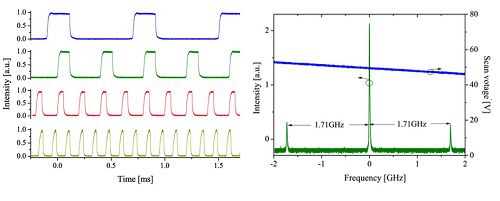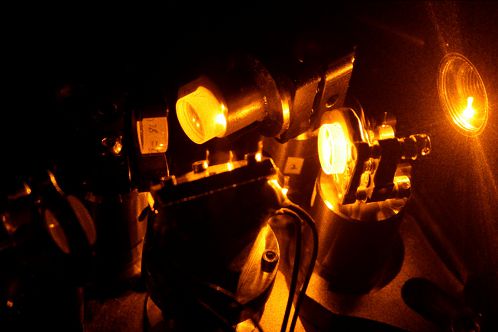Large aperture telescopes are built to observe universe more sharply. However, due to atmosphere turbulence, the image of stars is blurred. Astronomers use a technology called laser guide star adaptive optics to solve the problem. To do this, they need an artificial star above the atmosphere as a reference. The artificial star can be generated by shining a narrow linewidth laser at 589 nm on the sky to excite a layer of sodium atoms at about 90 km high.
Prof. Yan Feng et al in SIOM have been working on a fiber laser based method to generate sodium guide star laser. A 1178 nm laser is produced in optical fiber by stimulated Raman scattering, and then frequency doubled to 589 nm. In past few years, the group has developed technologies of high power 1120 nm linearly polarized single-mode pump fiber laser, high power single frequency Raman fiber amplifier, and high efficiency resonant frequency doubling etc.
The developed laser system can work in both pulsed and continuous-wave format. In the pulsed case, the 1178 nm Raman fiber amplifier produces square-shaped pulses with tunable repetition rate (500 Hz to 10 kHz) and duration (1 ms to 30 μs), while the peak power remain constant with a record peak power of 120 W. The 589 nm laser generated by frequency doubling in the resonant cavity has a peak power as high as 84 W. In the continuous-wave case, the same laser setup generates up to 57 W 589 nm output, which is the highest output ever reported for fiber based yellow laser. The 1.71 GHz re-pumping frequency component is generated by modulating the seed laser at 1.71 GHz and designing the doubling cavity with a free spectral range of 1.71 GHz in the laser. The power ratio and exact frequency shift can be easily tuned. The results are published on Laser and Photonics Review [Laser Photonics Rev. 8, 889–895 (2014)].
The flexibility of the laser system in both temporal and spectral format offers much design options for laser guide star adaptive optics. The robustness and high efficiency offered by fiber laser technology make the laser system promising for astronomical use.

Left: Tuning of laser repetition rate and pulse width; Right: Spectrum of the sodium guide star laser shows the presence of re-pumping light at 1.71 GHz blue.

Photo of the experimental setup for 589 nm laser generation
Home | About SIOM | Newsroom | International | Admissions | Publications | Contact
@ Shanghai Institute of Optics and Fine Mechanics Tel:02169918000 沪ICP备05015387号-1 Technical support:Qingyun Software